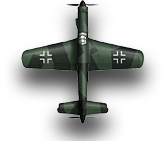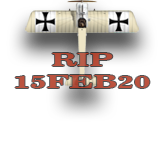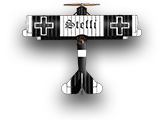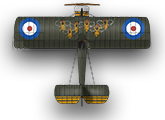Before I post any more info on Fliks I should cover the organization first.
The LFT-Units with aircraft
The nominal strength of a Fliegerkompanie (FliK) was 1 commander, 1 officer pilot as Chefpilot (pilot in chief), 7 NCO-pilots, 8 observing officers, 1 technical officer and 163 NCOs and men as supporting ground personnel. These 181 men were to have 6 aircraft ready for action, 2 aircraft as reserve, 2 cars and 3 trucks. This norm was fixed at the beginning of the war, which some FliKs never reached, but during the course of the war it became obvious that it would make more sense to specialize the different companies for different operational tasks. These differences in equipment and capability between the units was further indicated by a letter after the number of the company e.g. FliK 43J following this code:
D or Divisions-Kompanie these units were used at the divisional level for observation and artillery observation, also to provide support for the infantry and observation of enemy trenches within the divisional boundary, equipped with two-seat aircraft.
F or Fernaufklärer-Kompanie long range observation, directly subordinated to an army headquarters to observe the hinterland and the support routes of the enemy, equipped with two seat aircraft, in 1918 often transformed into Rb-FliKs
G or Großflugzeug-Kompanie these companies were organized as squadrons of twin-engines bombers combined with one seat fighters but the support of such huge planes was so low that in reality only the fighters were ready for action; the first of these units Fluggeschwader I was renamed as FliK 101G in September 1917, the others came in 1918
J or Jagdflieger-Kompanie fighter units against enemy aircraft ; the nominal strength should be 18 one-seater aircraft ready for action at each J-FliK but these figures were never reached because of support problems
K or Korps-Kompanie these units were to carry out the same missions as the D-FliKs but at corps level; created in late 1918 so actually no training or equipment changes came into effect
P or Photoaufklärer-Kompanie short range observers, equipped with one seater fighters with fixed photo-cameras and two seater Berg-aircraft reconfigured into one-seaters with photo cameras, formed in 1918
Rb or Reihenbildgeräte-Kompanie short range observers similar to the P-FliKs but equipped with modern serial picture cameras mounted on two-seater aircraft; mainly used in trench observation for infantry support
S or Schutzflieger- or Schlachtflieger-Kompanie originally created as escort for D-FliK observation companies but transformed in early 1918 into combat fighters to support infantry during the attack with bombing; also equipped with special MGs (Bombenloch-MGs) fixed on a swivel mount to the bombing aperture hatch in the bottom of the two seater plane so that the second crewman could fire directly down to earth to support ground troops
At the outbreak of war, the Air Service was composed of 10 observation balloons, 85 pilots, and 39 operable aircraft. By the end of 1914, they managed to have 147 operational aircraft deployed in 14 units. Just as Austria-Hungary fielded a joint army and navy, they also had army and naval aviation arms. The latter operated seaplanes; Gottfried Freiherr von Banfield became an ace in one. The Adriatic Coast seaplane stations also hosted bombers. Lohners were the most common variant; however, the K Series heavy bombers mounted a successful offensive against the Italians that suffered few casualties.
Austro-Hungarian pilots and aircrew originally faced off against the air forces of Romania and Russia, while also fielding air units in Serbia, Albania, and Montenegro. Only the Imperial Russian Air Service posed a credible threat, although its wartime production of 4,700 air frames gave it no logistical edge over the Luftfahrtruppen before the IRAS ceased operations in mid-1917. Nevertheless, the Austro-Hungarians requested, and received, aerial reinforcements from its German allies, especially in Galicia.
Italy's entry into the war on 15 May 1915 opened another front and brought the Empire's greatest opponent into the air war. The new front was in the southern Alps, making for hazardous flying and near-certain death to any aviators crashlanding in the mountains. To remedy Italy's initial shortage of fighter planes, France posted a squadron to defend Venice and oppose the Austro-Hungarians.
The 1916 Austro-Hungarian aviation program called for expansion to 48 squadrons by year's end; however, only 37 were activated in time. Two-seater reconnaissance and bomber squadrons often had a number of single-seat fighters integrated into the unit to serve as escorts on missions. This reflected the army high command's emphasis on tying fighters to defensive duty.
During 1917, Austria-Hungary pushed its number of flying training schools to 14, with 1,134 trainees. The expansion program was stretched to 68 squadrons, and the Air Service managed to activate the 31 units needed. Nevertheless, the Luftfahrtruppen began to lose its Italian campaign as Italian superior numbers began to tell. By 19 June 1917, the situation had deteriorated to the point where an Italian attack force of 61 bombers and 84 escorting planes was opposed by an Austro-Hungarian defense of only 3 fighters and 23 two-seaters. Within two months, the Luftfahrtruppen found itself facing over 200 enemy aircraft every day. Some of the disparity can be explained by the importation of four squadrons of the Royal Flying Corps to augment the Italian fighter force in the wake of the Battle of Caporetto.
Then, when winter came on, shortages of coal and other crucial supplies further hampered production for the Empire's Air Service.
Austro-Hungarian plans for 1918 called for ramping up its aerial force to 100 squadrons containing 1,000 pilots. Production climbed to 2,378 aircraft for the year. However, withdrawal of German air units to fight in France worsened the Austro-Hungarian's shortage of aircraft. By June 1918, the Luftfahrtruppen's strength peaked at 77 Fliks; only 16 were fighter squadrons. By 26 October, a fighter mass of some 400 Italian, British, and French airplanes attacked in the air even as Italian ground forces pushed for victory. The attrited Austro-Hungarians could only launch 29 airplanes in opposition. The local armistice on 3 November 1918 was the effective end of the Luftfahrtruppen, as its parent nation passed into history.
Luftfahrtruppen strength had peaked at only 550 aircraft during the war, despite having four fronts to cover. Its wartime losses amounted to 20 percent of its naval fliers killed in action or accident, and 38 percent of its army aviators.
Although all of the European powers were unprepared for modern air warfare in the beginning of the conflict, Austria-Hungary was one of the most disadvantaged due to the empire's traditionalist military and civilian leadership combined with a relatively low degree of industrialisation. The Empire's agricultural economy mitigated against innovation. Such industry as it possessed was used wastefully for aircraft manufacture; instead of producing single typles of aircraft from dedicated assembly lines, contracts were let to multiple factories, and individual factories were producing multiple types of aircraft. Shortage of skilled labor also hampered production. Technological backwardness was not limited to the usage of handicraft construction instead of assembly lines. For instance, the Austro-Hungarian fighter, the Hansa-Brandenburg D.I, lacked the gun synchronizer gear that would allow aiming the airplane's nose and firing its weaponry through the propeller arc. (note: at least two had synchronized gun).
Wartime production totaled 5,180 airplanes and 4,000 engines for four years of war; by comparison, Austria-Hungary's major foe, Italy, built about 12,000 in three years. Austro-Hungarian practice included inspection of completed aircraft by army officers before they left the factory.





 Reply With Quote
Reply With Quote












 So "Osmosis" is going to add some A-H History too?
So "Osmosis" is going to add some A-H History too? 






Bookmarks